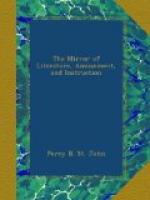Hawking.
Professional falconers have been for many years natives of the village of Falconsward, near Bois le Duc, in Holland. A race of them was there born and bred, whence supplies have been drawn for the service of all Europe; but as there has been no sufficient inducement for the young men to follow the employment of their forefathers, numbers are dead or worn out; and there only remains John Pells, now in the service of John Dawson Downes, Esq., of Old Gunton Hill, Suffolk.
The hawks which have been trained for the field, are the slight falcon and the goshawk, which are the species generally used in falconry. The former is called a long-winged hawk, or one of the lure; the latter, a short-winged hawk, or one of the fist.
The Icelander is the largest hawk that is known, and highly esteemed by falconers, especially for its great powers and tractable disposition. The gyr falcon is less than the Icelander, but much larger than the slight falcon. These powerful birds are flown at herons and hares, and are the only hawks that are fully a match for the fork-tailed kite. The merlin and hobby are both small hawks and fit only for small birds, as the blackbird, &c. The sparrow-hawk may be also trained to hunt; his flight is rapid for a short distance, kills partridges well in the early season, and is the best of all for landrails.
The slight falcon takes up his abode every year, from October and November until the spring, upon Westminster Abbey, and other churches in the metropolis. This is well known to the London pigeon-fanciers, from the great havoc they make in their flight.—Sir John Sebright
Technicalities of Science.
The inutility of science, written in a merely technical form, is well exemplified in the instance of Cicero. He was advised by his friends not to write his works on Greek Philosophy in Latin; because those who cared for it would prefer his work in Greek, and those who did not would read neither Greek nor Latin. The splendid success of his De Officiis, his De Finibus, his De Natura Deorum, &c., showed that his friends were wrong. He persevered in the popular style, and led the fashion.—Mag. Nat. Hist.
Doubtful Discoveries.
It may serve, in some measure, to confirm M. Dutroehet’s recent opinion of the non-existence of miscroscopic animalcula, that the celebrated Spallanzani persuaded himself that he could see Animalcula infusoria which could be seen by nobody else. He attributed his own superiority of vision, in this respect, to long practice in using the microscope. The philosopher exulted in his enviable distinction, when a peasant, to whom he showed his animalcula, could perceive nothing but muddy water.—Ibid.
Faculties of Brutes.
The dog is the only animal that dreams; and he and the elephant the only animals that understand looks; the elephant is the only animal that, besides man, feels ennui; the dog, the only quadruped that has been brought to speak. Leibnitz bears witness to a hound in Saxony, that could speak distinctly thirty words.—Medical Gazette.




